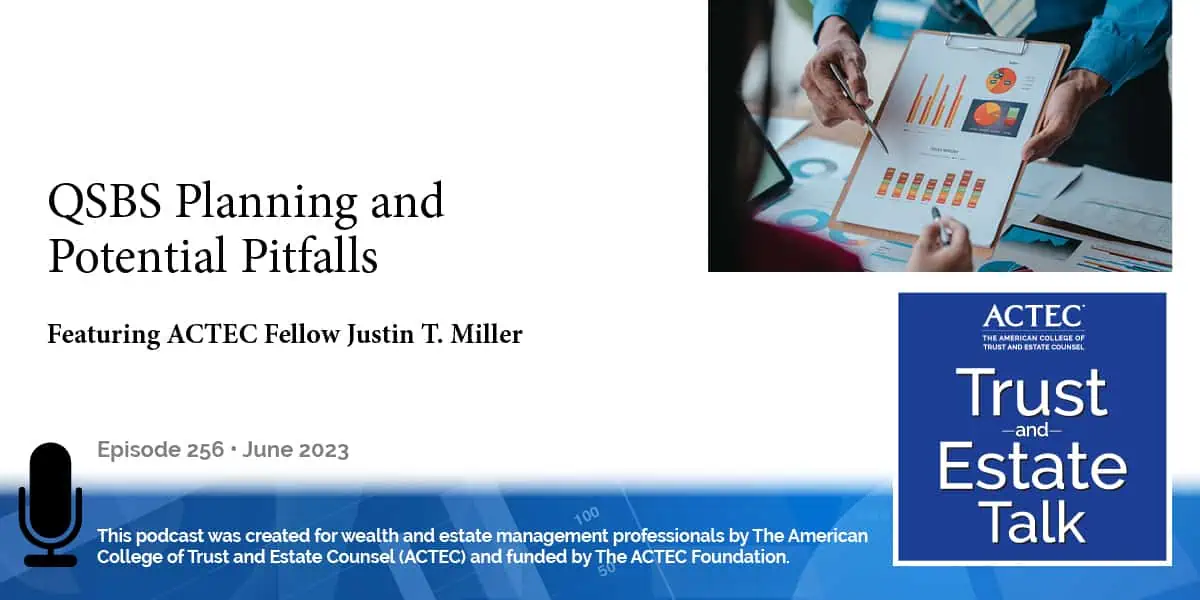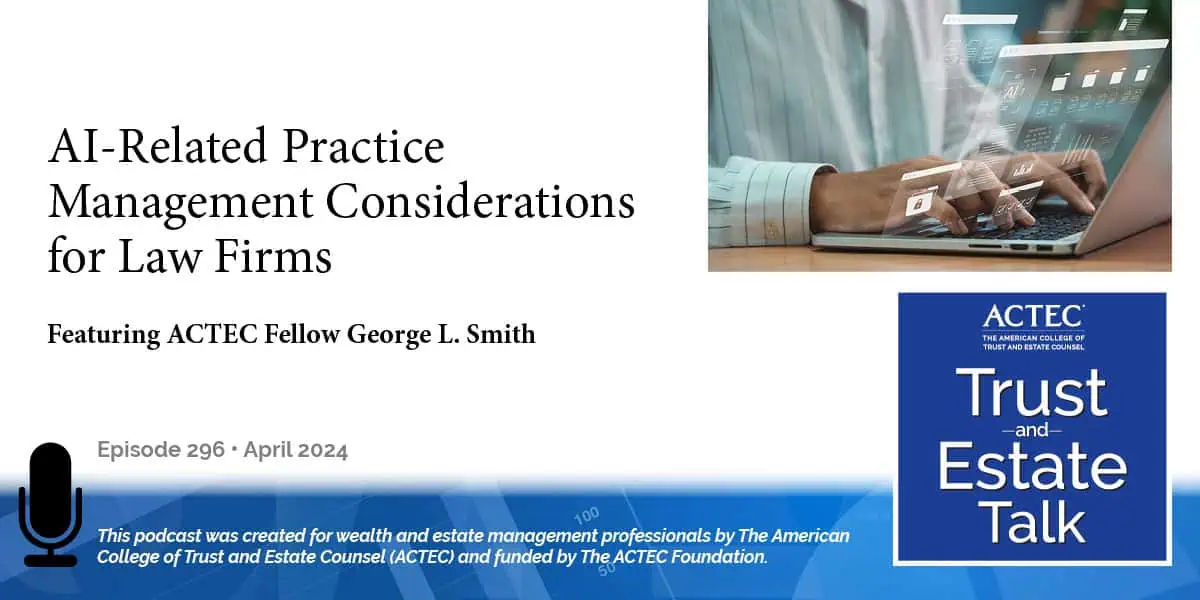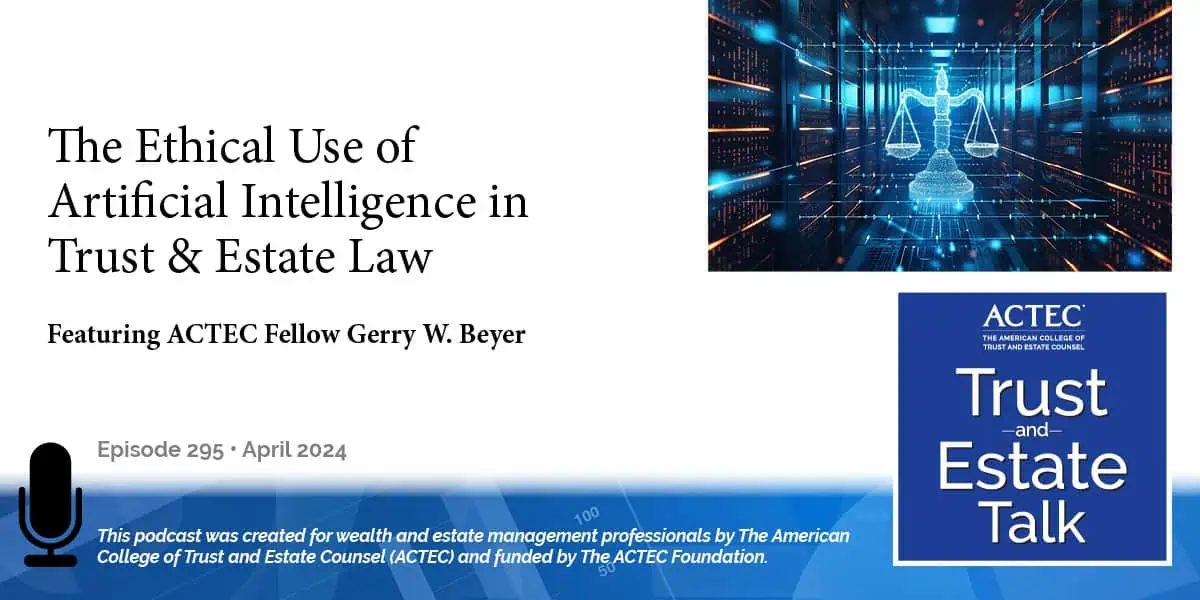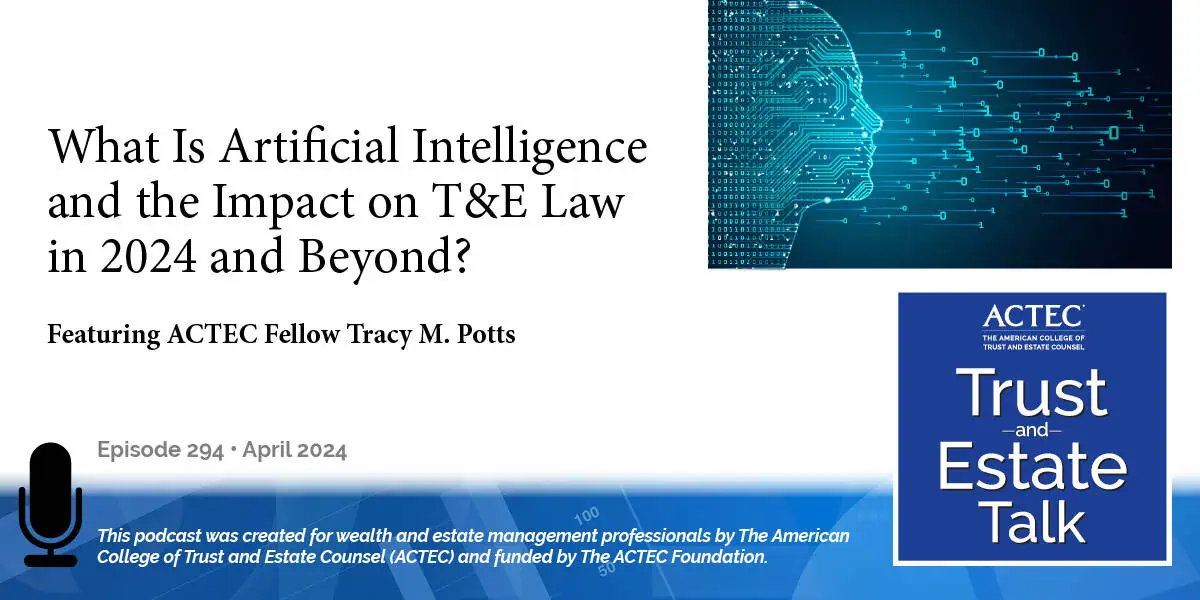QSBS Planning and Potential Pitfalls

“QSBS Planning and Potential Pitfalls,” that’s the subject of today’s ACTEC Trust and Estate Talk.
Transcript/Show Notes
This is Travis Hayes, ACTEC Fellow from Naples, Florida. QSBS, or Qualified Small Business Stock, refers to shares in a qualified small business that are subject to special capital gains tax rules. ACTEC Fellow Justin Miller of San Francisco, California, is here today with cautionary advice when creating and managing qualified small business stock. Welcome, Justin.
Justin T. Miller: All right. Well, thank you, Travis. So, today I am going to talk about planning opportunities with QSBS and potential pitfalls that we need to look out for. So, let’s just start with a quick background when we’re talking about QSBS or qualified small business stock. Or, if you want to be cool at the cocktail parties, you can call it “Section 1202 Stock” because that’s the section of the code that covers it.
What is QSBS?
So, just as a quick background, at QSBS, Section 1202, this could be the greatest thing since sliced bread. It’s a gift from the government. It offers you the greater of $10 million or ten times basis excluded from federal income tax. Some states also provide a state income tax benefit as well. So, greater of $10 million or ten times basis. Now, how much of that $10 million or 10 times basis can you exclude? Well, if you acquired that QSBS on or after September 28, 2010, you get a 100% exclusion of that amount. So, the greater of $10 million.
So, if you’re a founder and you have no basis in or very little basis in your stock, the first $10 million is completely tax-free. If you’ve invested in a qualified small business and, let’s say, you put $10 million in, you get ten times that amount; $100 million tax-free. But there are specific rules. First of all, it’s got to be a qualified small business. It’s got to be a C-corporation. It has to be at the time you acquired the stock, it has to have gross assets that don’t exceed $50 million. And you have to have received or gotten those shares directly from the company. There are a couple of exceptions we’ll talk about if you received it from a gift or inheritance or you received it from a partnership.
The other thing is that to be a qualified small business stock, it has got to be what’s called a qualified trader business. Not every C-corporation gets this treatment. What we know, according to the code, it gives a whole bunch of things that do not qualify. But mostly service-type businesses such as lawyers, accountants, architecture doesn’t qualify, performing arts, consulting. Basically, all the good-looking people that do services, we don’t get any of that benefit. So, it’s got to be a qualified small business. It’s got to be a qualified trade or business.
What Advisors Need to Understand About QSBS
But let’s assume we’ve got something that qualifies. You have yourself or a client that has received this QSBS. What are the opportunities? What do we need to look out for?
So, let’s start with the biggest question. Number 1, if you’re married, do you get one exclusion or do each (you and your spouse) get two exclusions? Now if you actually look at the code, it tells you what happens if you’re married filing jointly. It says, if you’re filing a separate return instead of married filing jointly, if you’re married but you’re doing a separate return, then you only get a $5 million exclusion each. But the code doesn’t say what happens if you’re not doing a separate return but you’re doing a married filing jointly return.
Now, I think it’s pretty- not so much of a stretch- to think that Congress, because they laid out what happens with separate returns, what they meant was, well, if you’re the opposite and you’re doing married filing jointly, you only get a $10 million exclusion. But there are advisors out there that would argue and make the argument that Congress only addressed separate returns. They never addressed married filing jointly. And they will point out and say that, in theory, maybe you could get two exclusions, one for each spouse. The original, if you look at the legislative history, this exclusion is supposed to be applied on a shareholder-by-shareholder basis.
There’s a technical advice memo out there, 9853002, that talks about treating married individuals as more than one taxpayer, that they’re each their own taxpayer. That dealt with 453 capital A installment sale type transactions. There’s even a tax court case, Nell v. Commissioner, Nell, N-E-L-L. And that dealt with the sort of an analysis that it’s a long-recognized legal maxim that a husband and wife are separate and distinct taxpayers. That’s what it says in that case.
Now, on the other hand, we don’t have any guidance from the IRS or Treasury specifically telling us whether you get two exclusions, one for each spouse. Because the code specifically addresses separate returns, it’s likely that there is only one exclusion. However, if you want to take that position, we don’t know whether you can or cannot. I would strongly recommend you consider a legal opinion because if it turns out that you’re wrong, that you took too many exclusions, that it turns out the answer is only one exclusion, even if you’re married filing jointly, you want to make sure that opinion letter will help you limit potential penalties and interest if it’s something that is found on audit. And assuming you don’t want to go and argue this all the way in tax court so that everyone can get the final answer. So that’s just number one.
QSBS Redemption
What do we also have to look out for? Redemptions. When you have qualified small business stock, especially founders, and you’ve got Series A and Series B and you want to start taking some money out of the company and have some of your shares redeemed, we have to be very careful. If there is a redemption of more than a de minimis amount and whether it’s just you or your family or whether it’s all the shareholders in general. That could disqualify all of your qualified small business stock. You might lose out on the exclusion just because of that redemption. So, we need to be careful there.
Another thing we have to look at is not only can you as an individual own QSBS, but that QSBS could be owned by a partnership or an S-corporation. Now the only benefit you will get as a partner or a shareholder of an S-corporation is if you were an owner of that entity at the time the entity purchased the QSBS. So, if I throw $5 million into a partnership with my other partner, let’s say who throws in their own $5 million, I’m limited to QSBS treatmentwhen that partnership eventually goes and buys that QSBS, my basis will be $5 million. I can get ten times that basis, $50 million, eventually, if the QSBS appreciates that much, will be tax-free, but I can’t go and buy out my partner’s interest and get my partner’s share of that QSBS.
The other thing we have to be careful for; do not contribute your QSBS to a partnership. The problem is if you contribute it, it disqualifies the QSBS. Now we love contributions to partnerships in the general estate planning context. You can get discounts for lack of marketability, lack of control. This is a great estate planning technique, but do not do it with QSBS. Otherwise, you could be ruining that exclusion. You’ll miss out on it.
Now what if you have an entity that is not a C-corporation? It may be possible to convert to a C-corporation to get to QSBS status. So, let’s say you’re an LLC, there is a way you could check the box to become a C-corporation. Starting at the point where you convert, from that point on, you will get QSBS treatment. Now, you might say, “Well what if we wait until my interest in the entire gross assets are $49 million?” Well, if I convert from an LLC to a C-corporation at $49 million, the first $49 million doesn’t get excluded. That first $49 million before it was a C-corporation, that’s going to be capital gain. But everything after that $49 million could qualify as QSBS. Now I don’t necessarily want to wait ‘til $49 million. What if I only sell the company for $51 million? Well, then, I’d only get to exclude $2 million. Two million more than my basis at the time I converted. But if I convert at $49 million and that company eventually sells for $600 million, I can get ten times my basis or $490 million.
So, just, it’s something we want to focus on. And the other thing is do not convert to a C-corporation just because of QSBS. We don’t know if somebody is going to buy your stock. What if it turns out that your acquirer is going to come in and wants to do an asset sale? So, we just have to be very clear whether or not we really want to be a C-corporation. Then we can do a QSBS analysis of whether it makes sense. An S-corporation can convert as well, it’s not quite as simple as an LLC. There’s still that $50 million gross asset test. It’s only for shares after you’ve converted to an S-corporation that are going to qualify.
The other thing to differentiate partnerships versus S-corporations, a partnership can actually distribute the QSBS out to the original shareholders at the time that QSBS was acquired. So, the same pro rata portion. An S-corporation does not have that same distribution requirement.
What if somebody comes and buys your firm in a tax-free reorganization? A section 368. Let’s call it a stock for stock. So, some big company comes in, and maybe even a publicly traded corporation buys your QSBS or buys your qualified small business. Well, it’s no longer a QSBS stock, but the benefit does continue. Your QSBS it’s almost like it’s frozen in time. Whatever the value was at the time of that tax-free reorganization, you will continue to get that benefit.
The other thing to be aware of — what if you don’t meet the holding period? You need to hold it for at least five years to get the benefit of this $10 million or ten times exclusion. But if you don’t meet that holding period, you would lose out on the benefit. What if someone comes four and a half years into you holding the stock and then buys the stock? You would not get the exclusion. But there is a special rule under section 1045, it’s called a “QSBS rollover”. You can turn around and buy new QSBS, and that new QSBS, you would basically tact your holding period. You would be able to sell it six months, a year later, and you get the special rollover rule so you don’t lose your QSBS’s benefit. In fact, you could, in theory, start your own new qualified trader business and roll your proceeds into that new business. Let’s just hope and make sure that it’s a legitimate, qualified trad or business. You have a business plan, operating entity, it’s a C-corp. But in theory, you could do the 1045 rollover to your own business.
Transferring QSBS to a Trust or Estate
Last but not least, I just want to point out if you have children or grandchildren or other loved ones that you want to transfer stock to for estate planning purposes, QSBS, you can multiply your QSBS benefits. Sometimes it’s called “stacking.” And what that is, is whoever you transfer to, whether it’s an individual or even better a trust, protected in trust, asset protection for potentially generations, each non-grantor trust that your set up gets its own exclusion. So, what that means is, that let’s say I’ve got three children, I can use up my exemption amount $12.92 million per person right now. I could put four million each into one trust for each of my three kids. $4 million each, I’ve used up my exemption amount. Not only that, those trusts can eventually sell the stock. Each one of those trusts, the first $10 million will be completely free of income taxes.
Not only that, each one of those trusts that I set up, if I am in a state that doesn’t give you a qualified small business exclusion like California if I set those trusts up in a non-tax state– let’s say like a Delaware, Nevada, something like that– I could potentially avoid state taxes as well. Not only do I eliminate the federal income, the state income tax, but each one of those trusts also will continue to grow free of gift, estate, or GST taxes. So very, very powerful way to multiply your exclusions.
QSBS Cautions
You might ask as a final topic, “Hey, why don’t I do 10 of these non-grantor trusts or 100 of these non-grantor trusts?” And the reason why is we have a section 643(f). If these trusts are too similar, substantially the same grantor and beneficiaries, principal purpose is avoidance of tax, hen what happens is under the code, each one of those multiple trusts will be treated as one trust. You’d only get one exclusion. But back to my original example, you have three children. You certainly, those are three different beneficiaries. You can do three different trusts. Anything more aggressive than that if you’re trying to mix and match, unfortunately, the IRS will no longer allow you to get any comfort level with the private letter ruling. Rev Proc 2021-3 says, “We will no longer rule on whether or not you’re creating multiple trusts that will fall under 634(f).”
And with that, I hope this helped you learn about some planning opportunities and potential pitfalls about QSBS. Thank you so much for your time. And I’ll turn it back to Travis.
Travis Hayes: Thank you, Justin for discussing qualified small business stock and planning issues and potential pitfalls relating to QSBS.
You may also be interested in:
- Don’t Guess and Make a Mess with QSBS (Oct 2021)
- Using Multiple Non-Grantor Trusts for Multiple Tax Benefits (June 2021)
If you have ideas for a future ACTEC Trust & Estate Talk topic, please contact us at ACTECpodcast@ACTEC.org.
© 2018 – 2024 The American College of Trust and Estate Counsel. All rights reserved.
Latest ACTEC Trust and Estate Talk Podcasts

AI-Related Practice Management Considerations for Law Firms
A discussion for law firms about how to incorporate AI in their practice management, including staff considerations, the “billable hour,” and more.

The Ethical Use of Artificial Intelligence in Trust & Estate Law
A law professor offers insights into the risks, rewards, duties and ethical considerations of lawyers using AI in their T&E practices.

What Is Artificial Intelligence and the Impact on T&E Law in 2024 and Beyond?
A primer on the types and uses of AI, then a deeper dive into the impact on trust and estate law from types to applications to ethical considerations.

